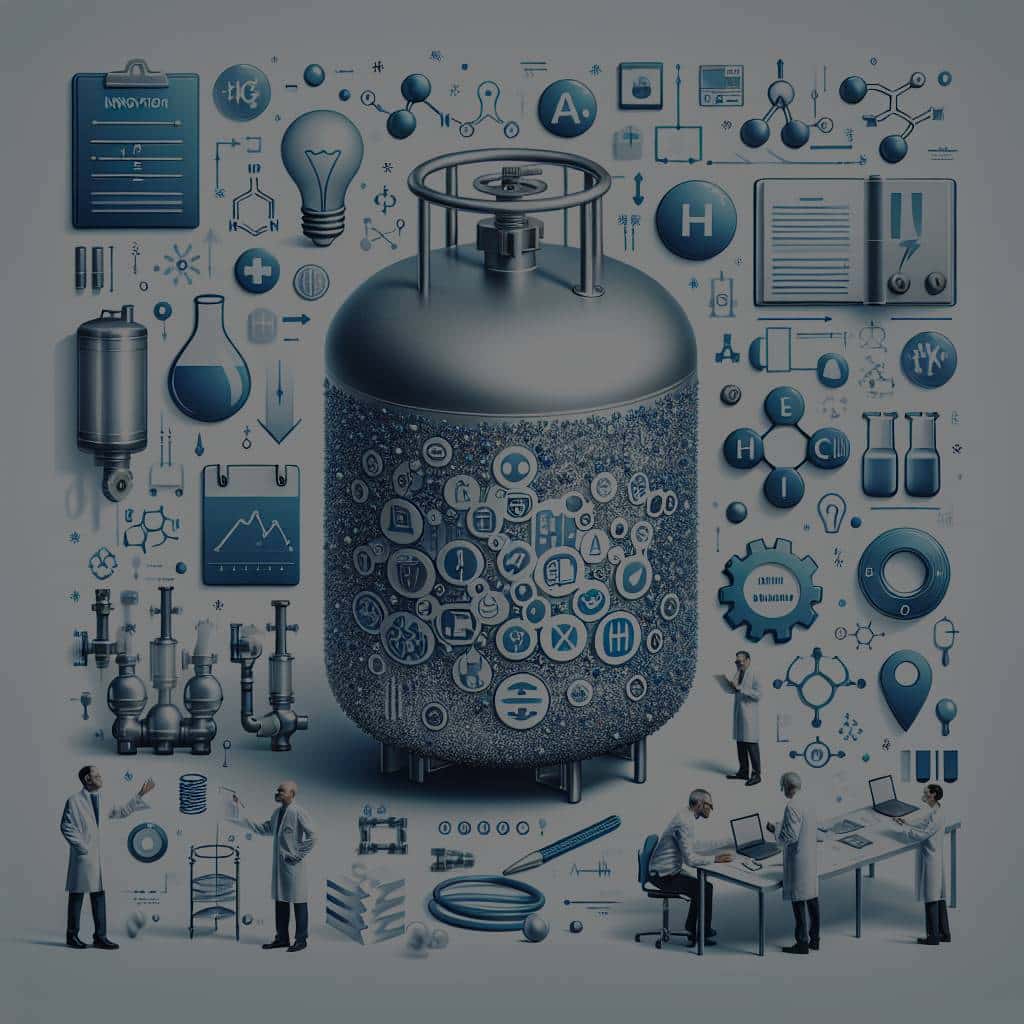What Innovations Are Key to Developing Long-Lasting Hydrogen Storage Solutions?

Hydrogen has long been acknowledged as a potentially game-changing element in the realm of energy. Its promises of a cleaner, more efficient form of energy have been hailed as key in transitioning from carbon-based fuels to renewable energy sources. However, one of the biggest challenges lies in creating efficient and sustainable hydrogen storage solutions. This article delves into the innovative technologies and materials that are paving the way for the development of long-lasting hydrogen storage systems.
Harnessing Hydrogen: The Potential and Challenges
Hydrogen is the most plentiful element in the universe, and it holds significant potential as a source of power. When used as fuel in a fuel cell, it can produce electricity without emitting harmful greenhouse gases. However, hydrogen’s potential is yet to be fully realized due to storage challenges.
Lire également : Can Smart Dust Sensors Transform Environmental Monitoring Strategies?
Hydrogen gas is incredibly light and diffuse, which makes it difficult to store and transport efficiently. Traditional storage methods involve compressing hydrogen at high pressure or cooling it to a liquid state, but these approaches have significant drawbacks. They require extensive energy input, create safety risks, and can lead to hydrogen loss through evaporation or leakage.
To unlock the full potential of hydrogen, innovative storage technologies and materials are crucial. These solutions aim to overcome the aforementioned challenges, making hydrogen storage safer, more efficient, and economically viable.
Cela peut vous intéresser : Will Continuous Glucose Monitoring Smartwatches Revolutionize Diabetes Management?
High-Pressure Tanks: Advancing Material Technology
High-pressure tanks are one of the most common methods for storing hydrogen. These tanks typically store hydrogen gas at pressures up to 700 bar. However, this approach necessitates robust, resilient materials that can withstand such high pressure without rupturing.
Advanced composite materials are key in this respect. These materials, often based on carbon fiber, are incredibly strong yet lightweight. They can withstand high pressure while keeping the weight of the tank to a minimum.
Innovations in composite material technology are also improving the tanks’ resistance to hydrogen embrittlement. This phenomenon occurs when hydrogen atoms infiltrate the tank’s material, compromising its structural integrity. The development of hydrogen-resistant composite materials is therefore crucial in ensuring the longevity and safety of high-pressure hydrogen storage tanks.
Metal Hydrides and Chemical Hydrides: Compact Storage Solutions
Metal hydrides and chemical hydrides present another innovative approach to hydrogen storage. These are materials that can absorb hydrogen atoms, storing them in a compact, dense form. This allows for a significantly greater amount of hydrogen to be stored in a given volume compared to gas or liquid storage methods.
In terms of metal hydrides, alloys of titanium and iron, among others, have demonstrated promising hydrogen storage capacities. Meanwhile, chemical hydrides such as sodium borohydride and ammonia borane are also being explored for their storage potential.
The challenge, however, lies in the release of hydrogen from these materials. This typically requires heat, which can compromise the energy efficiency of the storage system. Research is currently underway to develop hydride materials that can release hydrogen at lower temperatures, thereby improving the system’s overall efficiency.
Cryogenic Liquid Hydrogen: Cooling it Down
Cryogenic liquid hydrogen storage involves cooling hydrogen gas to extremely low temperatures, converting it into a liquid form. This approach is particularly advantageous in terms of storage density, as liquid hydrogen occupies less space than its gaseous form.
However, maintaining such low temperatures requires substantial energy input and sophisticated insulation technologies. Current innovations in this area are focused on developing more efficient cooling systems and superior insulation materials.
Another challenge associated with cryogenic liquid hydrogen storage is boil-off. This occurs when heat leaks into the storage system, causing some of the liquid hydrogen to evaporate. To address this, innovative systems are being developed to recapture and reuse this boiled-off hydrogen, therefore minimizing loss and improving the longevity of the storage solution.
Solid-State Hydrogen Storage: A Promising Frontier
Solid-state hydrogen storage represents another promising frontier in the field. This approach involves storing hydrogen within solid materials, such as metal-organic frameworks or carbon nanotubes. These materials have porous structures that can trap hydrogen atoms, storing them in a compact and stable form.
Solid-state hydrogen storage solutions offer numerous benefits. They operate at relatively low pressure, reducing the safety risks associated with high-pressure gas or liquid storage. They also have high storage densities and can operate at room temperature, which can enhance the energy efficiency of the storage system.
However, there are also challenges to overcome. The main one is finding ways to rapidly and efficiently release the stored hydrogen when it’s needed. Current research in this area is focused on designing materials with optimal pore sizes and structures, which can facilitate the quick and easy release of stored hydrogen.
In conclusion, there is no one-size-fits-all solution in the quest for efficient and sustainable hydrogen storage. The most effective approach will likely involve a combination of these innovative technologies and materials, tailored to specific use cases and environments. With continued research and development, the full potential of hydrogen as a clean, renewable energy source will undoubtedly be realized.
The Role of Startups and Scaleups in Hydrogen Storage Solutions
Startups and scaleups play a pivotal role in the development of advanced hydrogen storage solutions. They drive innovation, pushing the boundaries of existing technologies and exploring new materials and methods for efficient hydrogen storage.
One area where startups and scaleups have been particularly active is in the development of high-capacity storage systems. These systems aim to maximize the amount of hydrogen that can be stored in a given volume, thereby increasing energy density. Startups are exploring various approaches, from advanced high-pressure tanks and metal hydrides to cryogenic liquid hydrogen and solid-state storage solutions.
Startups are also crucial in scaling up hydrogen production and storage technologies. To make hydrogen a viable alternative to fossil fuels, it’s necessary not just to develop efficient storage methods, but also to scale them up to meet the demands of power generation and transportation industries.
Several startups and scaleups are working on large-scale hydrogen storage solutions. These systems are designed to store massive amounts of hydrogen, making it possible to harness the full potential of this abundant element for power generation. They are also developing technologies to efficiently distribute the stored hydrogen, whether it’s in gas, liquid, or solid form.
In short, startups and scaleups are at the forefront of the quest for sustainable, efficient, and large-scale hydrogen storage solutions. They are the key drivers of innovation, constantly pushing the envelope to unlock the full potential of hydrogen as a clean energy source.
Conclusion: The Future of Hydrogen Storage
The challenges in hydrogen storage are significant, but the potential rewards are vast. Efficient and sustainable hydrogen storage solutions could unlock a new era of clean energy, reducing our reliance on carbon-based fuels and helping to mitigate the effects of climate change.
While there are several innovative technologies and materials under development, there is still much work to be done. High-pressure tanks, metal and chemical hydrides, cryogenic liquid hydrogen, and solid-state storage all show promise, but each has its own set of challenges to overcome.
The role of startups and scaleups in this journey cannot be overstated. They are instrumental in driving innovation, scaling up hydrogen production, and developing efficient, large-scale storage systems. The future of hydrogen storage will likely involve a mix of these technologies, tailored to suit various use cases and environments.
In conclusion, the road to sustainable hydrogen storage solutions may be long and challenging, but the destination is worth the journey. With continued innovation and investment, the dream of harnessing hydrogen’s full potential as a clean, renewable energy source can become a reality. The development of efficient hydrogen storage systems is not just about creating a new form of energy storage; it’s about building a cleaner, more sustainable future for us all.
